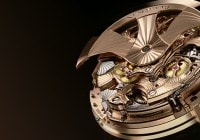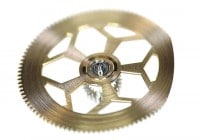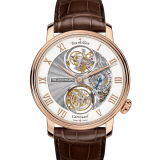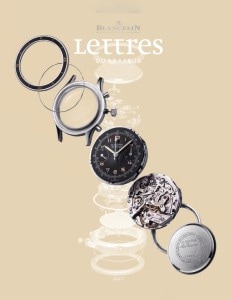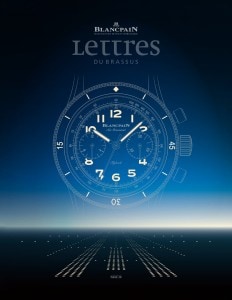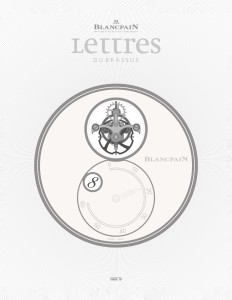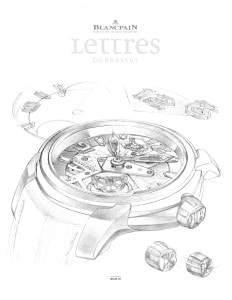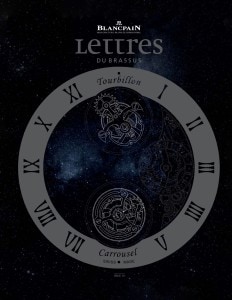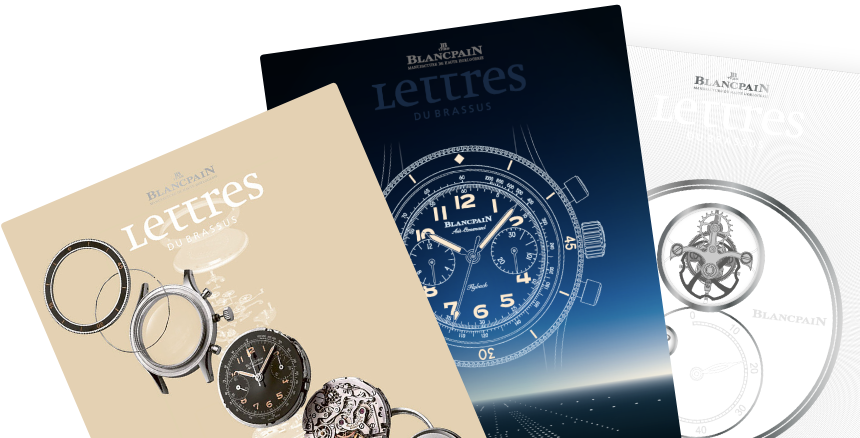
Search in Issues
Chapters
List of parts
Chapter 1
Le Brassus TOURBILLON CARROUSEL
A world first: a carrousel and a tourbillon brought together in a wristwatch.
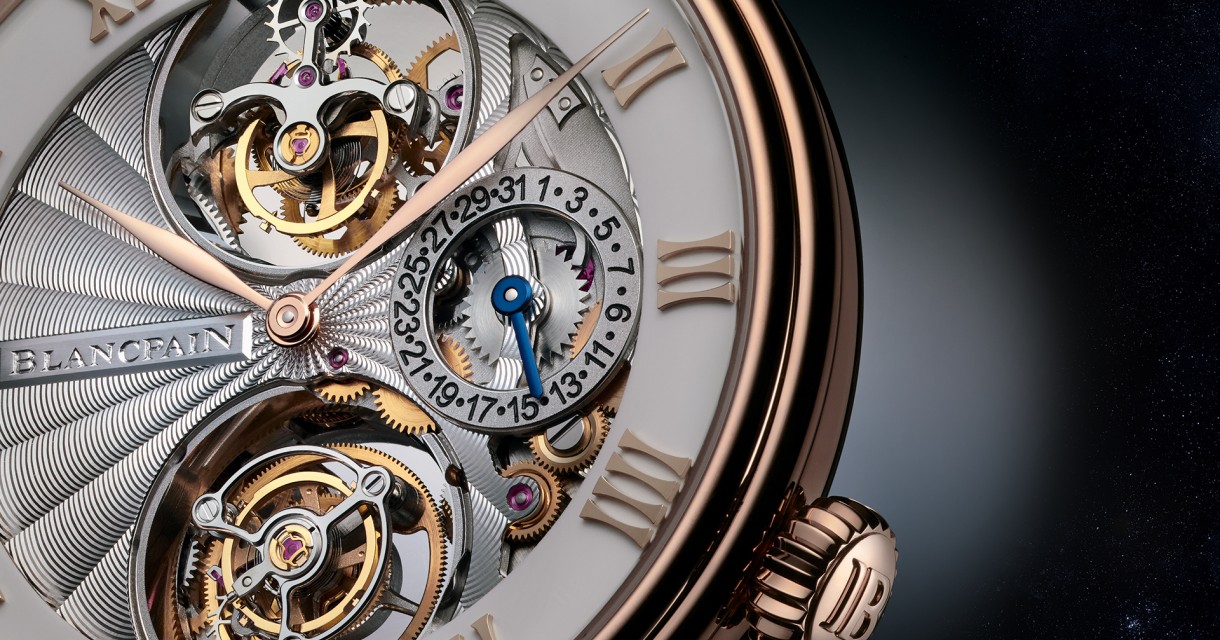
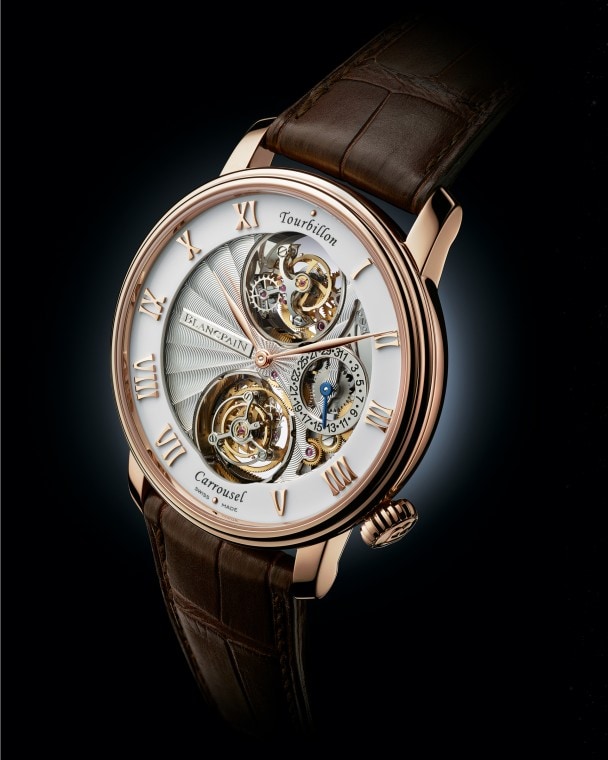
The development of the Tourbillon Carrousel was a “NEVER BEEN DONE BEFORE” project.
The instruction from Marc A. Hayek in 2009 seemed crisp. “Let’s explore making a watch that marries a tourbillon and a carrousel.” Marries? What in the world did he mean? That was left to Blancpain’s watchmakers to decide. They had just been given the ultimate in creative freedom, to develop proposals somehow linked to the concepts of tourbillons and carrousels and that could be tucked into one of the many definitions of the word “marries”.
Flights of fancy soared from their commission. “What if we somehow merge a tourbillon into a carrousel or the reverse?” That idea lasted not long at all. The key element of a tourbillon is a fixed gear around which the timing components of a watch rotate and the key element of a carrousel is that it rotates the timing components without a fixed gear. No way to mash those two into a single device. So early on the focus became the development of a timepiece never before created that would feature both a tourbillon and a carrousel; they would be married by putting both of them into the same watch.
As with every “never been done before” project, the next steps pointed in multiple directions. If both a tourbillon and carrousel are placed in the same watch should there be a single barrel which powers both of them and, if so, where should each of these elements be placed within the case? Barrel on top, with the tourbillon and carrousel placed somewhere below or the reverse or perhaps left side/right side? Each of these configurations was explored before a better idea emerged: have separate winding barrels for the tourbillon and carrousel. With separate barrels an harmonious arrangement with the tourbillon and carrousel aligned vertically could be achieved.
That decision charted the course for what followed. That’s not to say that invention stopped at that point or even began with the delivery of Marc Hayek’s challenge in 2009. The Tourbillon Carrousel that debuted at Basel 2013 was the product of inventions that began in the mid 1980’s and that have steadily continued for the following more than quarter century. Logically there have been three principal theatres of innovation that come together in the Tourbillon Carrousel: first, Blancpain’s original creation of its tourbillon, the world’s first one minute flying tourbillon; second, the development of its carrousel, the world’s first flying one minute carrousel; and three, the development of the means to put both these core inventions into a single watch.
Before turning to the four year development path for the combination, step back for a moment to examine the two “marriage partners” for each on its own represents a landmark development in watchmaking.
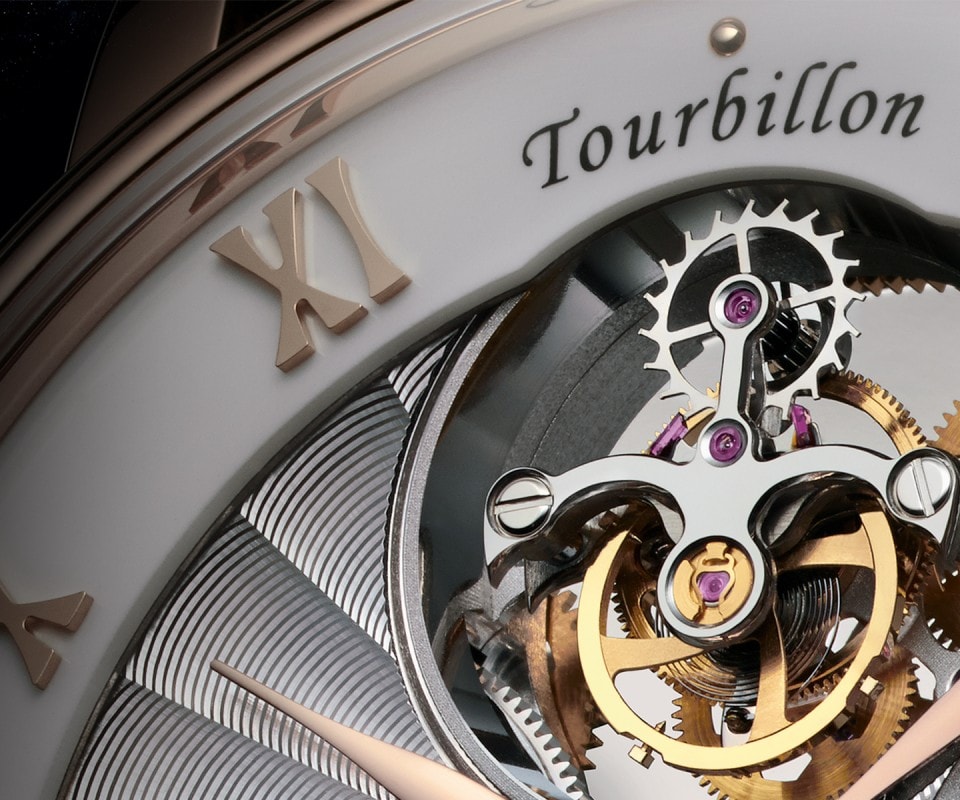
Creating a tourbillon with A FLYING DESIGN and with an off-center balance wheel was more difficult than following pre-existing designs.
Blancpain Flying One Minute Tourbillon. Blancpain’s flying one minute tourbillon, in common with all tourbillons since the invention of the first tourbillon patented by Abraham-Louis Breguet in 1801, is designed to overcome gravity caused variances in the running rate of a watch associated with changes in vertical position. It is inevitable that a mechanical watch, no matter how carefully made, will run ever so slightly faster or slightly slower depending on its vertical position (the positions are classically defined as crown facing up, facing down, facing right, facing left). The core idea behind the tourbillon is to rotate constantly the rate keeping components over a full 360 degree circle on a periodic basis (one minute rotation is the overwhelming norm with modern watches) so that these positional rate errors produced by gravity will cancel each other out. In all tourbillons the way in which this rotation of the time keeping components is accomplished is to place them within a cage which is rotated about a fixed gear. That was the core of the original 1801 patent and remains the core of tourbillon design today.
Blancpain’s original tourbillon, developed beginning in the mid-80’s, elaborated on what were seen as standard tourbillon constructions. The norm over the preceding 180 year period of tourbillon watchmaking suspended the rotating tourbillon cage between two bridges (one on top, the other on the bottom) and centered the balance wheel within the cage. The design team saw a way to enhance this standard construction by eliminating the top bridge and by moving the balance wheel slightly off center in the cage. These enhancements carried with them enormous advantages. First by removing the top bridge, visibility of the tourbillon mechanism was greatly improved, since no longer would there be a bridge standing between the tourbillon and the owner. This type of single bridge design is termed a “flying tourbillon” as the sole support for the rotating cage is a bearing on the bottom side giving the topside appearance of a cage “flying” in space. Second, by decentering the balance wheel Blancpain was able to reduce greatly the thickness of the cage, thereby creating the world’s thinnest tourbillon.
Both of these Blancpain tourbillon innovations made the construction significantly more difficult than with the pre-existing standard designs. The description itself of the flying design teaches the added difficulty that it carries with it: one bridge instead of two for the support of the rotating cage. This necessitated the development of a ball bearing support system for the cage on the lower bridge, which over time has been improved by fashioning the bearings in ceramic. How revolutionary was it to build the first wristwatch flying tourbillon? Not only was Blancpain the first to notch this achievement, its flying tourbillon was the first one minute flying tourbillon in any size watch— pocket or wrist.
Blancpain Flying One Minute Carrousel. The basic idea of the carrousel is identical to that of the tourbillon: constant rotation of the time keeping elements of the watch in order to cancel out gravity caused variances in running rate in a vertical position. The key difference between the carrousel and tourbillon is the means by which this rotation is accomplished. With the tourbillon a fixed gear in employed. That rotation is used to deliver power to the balance wheel/escapement. With a carrousel there is no fixed wheel and two power trains are employed, one to rotate the cage and the second to power the balance wheel/escapement.
The carrousel was originally developed by a Danish watchmaker then living in England, Bahne Bon- niksen. Bonniksen’s original idea was to develop a precise watch which would avoid Breguet’s tourbillon patent. Secondarily, he hoped that the construction would be less costly than that of a tourbillon. He succeeded magnificently on the first objective and failed on the second. Although carrousel pocket watches proved themselves superior to tourbillons from a performance perspective, far from being less expensive to produce, as they were more complicated with a higher component count, they were more costly.
In spite of the extra cost, carrousel pocket watches inspired by Bonniksen, largely produced in Coventry where Bonniksen lived, flourished for a period around the turn of the century. Indeed, in 1904 38 of the best 50 watches submitted for a timing competition at the Kew Observatory in England were carrousels and those watches swept the competition. Unfortunately for the world of watchmaking, construction of carrousels was completely centered in Britain so that when the English watchmaking industry collapsed, carrousel production fell with it and disappeared from view.
When the team was assembled to construct the first carrousel for a wristwatch, it was reviving what was essentially forgotten watchmaking art. As it had with the tourbillon, Blancpain was not content merely to re-create existing designs. The resulting construction broke new ground on many fronts. When it debuted at Basel 2008, Blancpain’s carrousel was not only the first carrousel in a wristwatch, it was the first flying one minute carrousel ever produced and offered the longest power reserve of any carrousel in history.
There was one more respect in which this ground breaking carrousel opened a new pathway, one dipped in a degree of irony. Blancpain’s flying tourbillon set itself apart from the pack by de-centering the balance wheel. Precisely the opposite architecture was employed with the carrousel. Whereas historical pocket watch carrousel designs featured balance wheels de-centered in the cage, Blancpain distinguished its carrousel by centering the balance wheel in the cage.
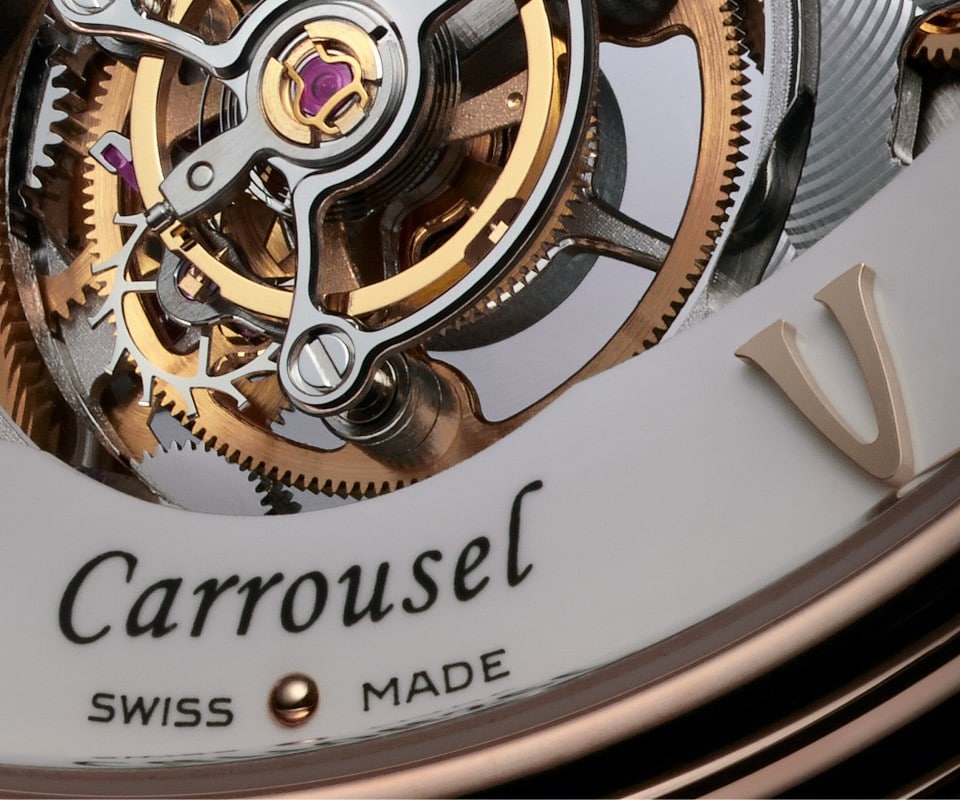
The Marriage. Resolving the dilemma of one barrel for both and the placement of the elements was only the beginning of the design challenges for the incorporation of these two iconic Blancpain constructions into the same watch. One of the first to be faced, at first blush, might seem mundane, trivial even. If there were to be two barrels, one each for the tourbillon and carrousel, how should they be wound? With a single crown, certainly. However, with the tourbillon and carrousel arranged vertically in the watch, the two barrels could not be located adjacent to each other. Indeed, they would need to be placed opposite each other. So the question became how to wind two barrels remote from each other.
The solution took the form of a large winding ring running around the circumference of the movement. Fitted with teeth, this large exterior ring engages winding gears for each of the barrels simultaneously. Despite its “ring-like” shape, Blancpain’s movement designers prefer referring to the ring as the “crown” because its purpose is in fact that: winding the two barrels.
The realization of this exterior winding ring solution was far from simple. The issues centered around how to support the ring. Several different elements were designed to hold the ring in position. To center it laterally, four ruby bearings have been located around the exterior of the movement. The placements are strategic, three of them at the points of greatest stress—adjacent to each of the two winding wheels for the barrels and next to the staff of the crown. A steel bearing in the form of a disk is located on the top surface of each ruby bearing to provide vertical support.
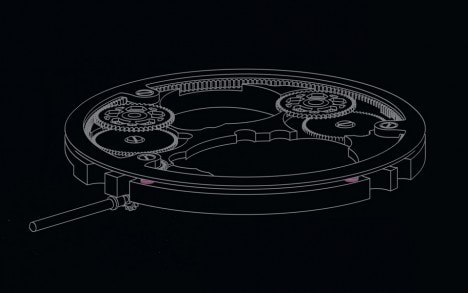
An exterior ring connected to the crown winds both barrels simultaneously.

The BALANCE WHEELS AND SPIRALS are identical featuring inertial regulation and silicium hairsprings.
Vertical support in the other direction comes from disk shaped steel bearings built into the interior surface of a circular bridge which lies above the full circle of the winding ring. The ring itself is exceedingly difficult to produce. Because of its complex shape each and every tooth along its circumference must be individually cut.
There is another aspect to this “marriage” beyond common winding: bringing some common design elements to the tourbillon and carrousel. Both the balances and spirals of each have evolved and now are shared. For the first time Blancpain has fabricated the balance spirals for the tourbillon and carrousel in silicium. Along with the new silicum spirals come new balance wheel designs with inset gold inertial regulation screws. This type of screwed inertial regulation (a feature of all recent Blancpain movements) allows for greater precision in the regulation of the watch and superior resistance to changes if the watch is subjected to shock. For the Tourbillon Carrousel, there are insets in the balance wheel at each of the four locations of the regulation screws. This allows for a slightly larger diameter balance wheel to be fitted within the cages. In each of these respects—silicium spiral, inertial regulation, design of the balance wheel—the tourbillon and carrousel are identical.
Savvy watch collectors, by this point, will no doubt be asking themselves how the outputs of the two timekeeping elements are combined into one time display. The answer is a differential. There are two exterior wheels which are fabricated for the differential, each engaged with a pinion, one from the tourbillon,
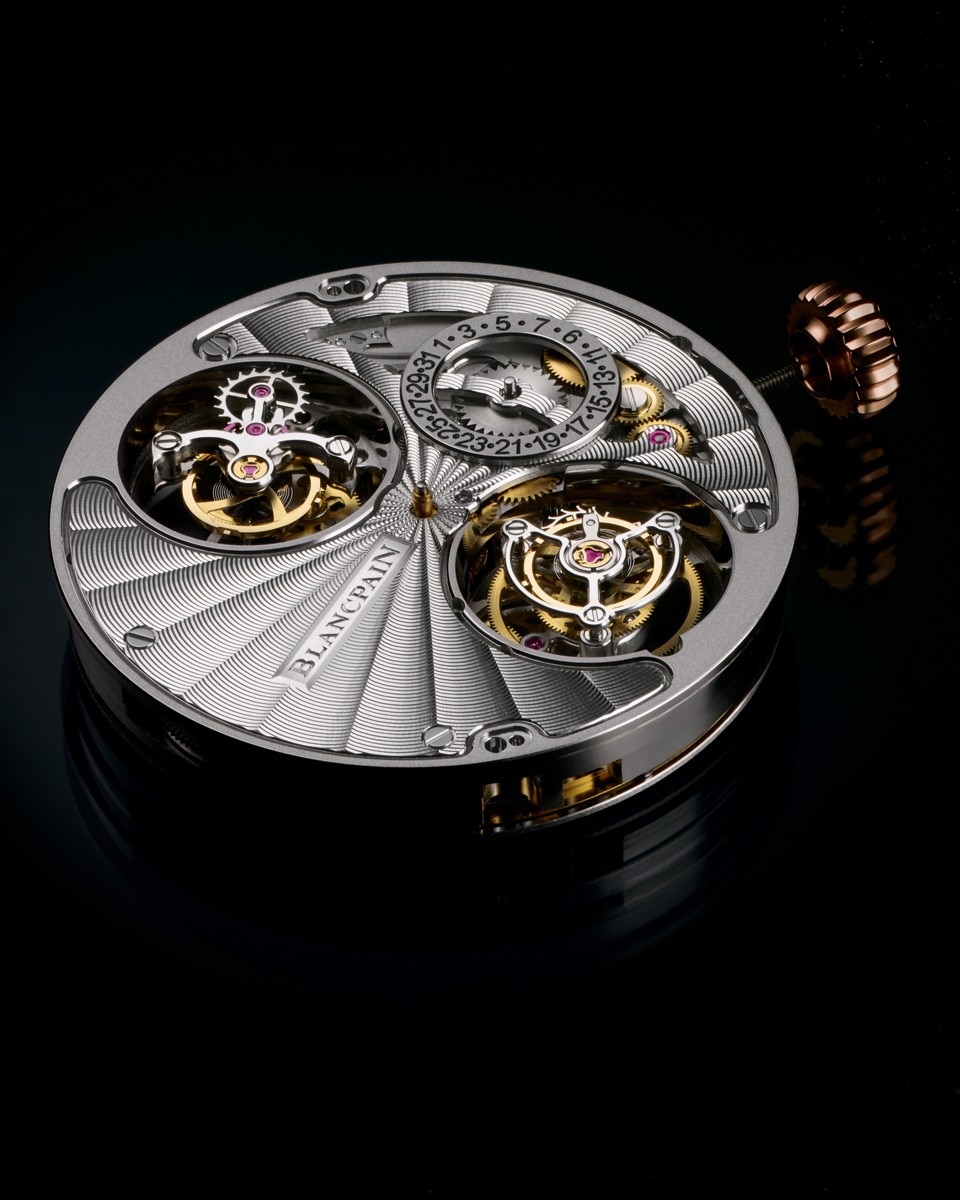
The two barrels WIND TOGETHER via the large wheel circling the movement.
the other from the carrousel. The pinion is mounted upon what is termed a “satellite”. The minute hand of the watch, in turn, is connected to a staff which rotates with the satellite. If both the tourbillon and carrousel are running at an identical rate, the relative position of the satellite pinion will not change and it will rotate at the common speed of its two inputs. On the other hand, if there is a difference in the rate of the two inputs, the satellite will rotate at a rate which averages the difference. Although the construction is complex, the result is rather simple to understand. With two inputs the results are averaged. So, for example if the tourbillon were to be running +2 seconds a day and the carrousel -2 seconds a day, the result would be perfect timing. Another example: if the tourbillon were running at +/- 0 second per day and the carrou- sel +2 seconds per day, the result would be +1 second per day.
In fact, there are three differentials which have been built into the movement of the Tourbillon Carrousel. In addition to the differential to combine and average the outputs of the two timekeeping elements, there is a differential for the power reserve display and another for the correction of the date display. The power reserve indication, itself, is found on the reverse side of the timepiece.
There is one final movement design detail that needed attention for the marriage to be successful: the power reserve. Blancpain’s original carrousel that debuted in 2008 had a power reserve of 100 hours, which was at the time a world record for a carrousel timepiece. Also establishing world records when they debuted, Blancpain’s tourbillons boasted power reserves of up to eight days. Since, of course, both need to run together, Blancpain’s designers set the power reserve bar at seven days and designed a new larger winding barrel for the carrousel for it to achieve the new mark.
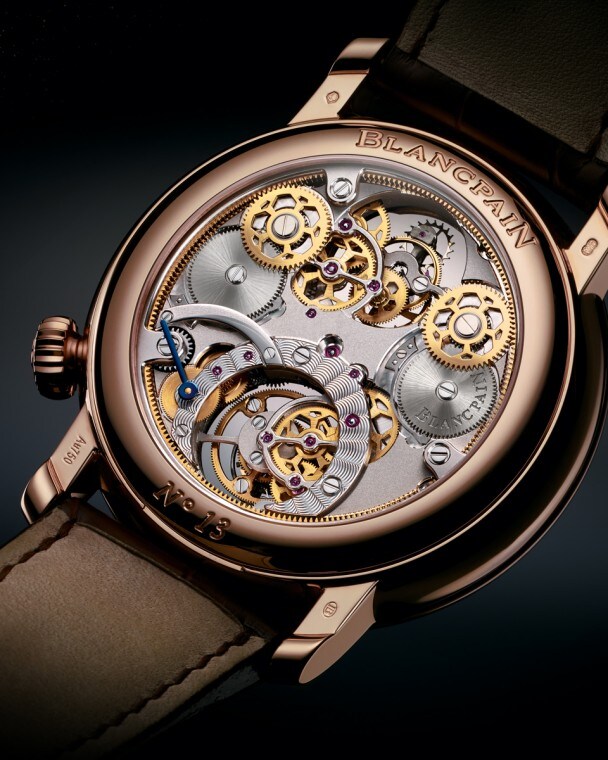
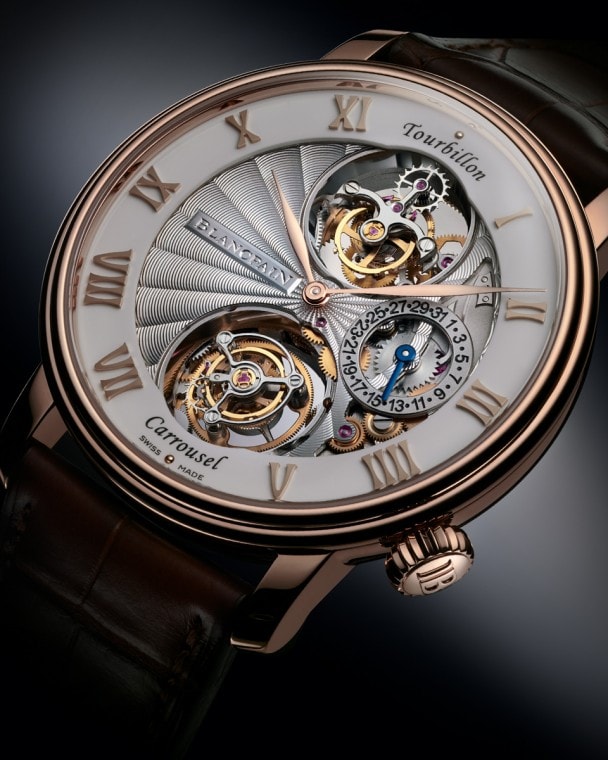
The decoration of the movement reflects the sophistication of its construction. The dial side of the Tourbillon Carrousel is opened to place the main plate directly in view. For the first time on one of its movements, Blancpain has hand carved a guilloche finish, in a motif known as “flanqué.” On the back side, the bridges feature a rhodium plated fine frosted finish on the flat surfaces and hand filed and burnished anglage on the edges. If you have an eye for refined detail, note the precision with which the frosted finish has been applied; there are distinct borders between the edge of the frosted finish and the bright polished edge of the anglage which highlights the beauty of both. Two final flourishes. The power reserve display uses the contrast between a background frosted finish and mirror polishing to show the state of wind. A ring has been placed around the carrousel porthole, which like the front of the movement, has been hand guilloched. The dial of the watch has been realized in full fired enamel. To give the dial added depth, layer after layer of enamel are applied, each baked before the next is applied. Unusual for an enamel dial, red gold indexes have been added.
The Tourbillon Carrousel is housed in a 44.6 mm red gold case.



